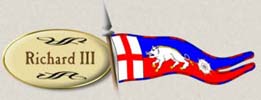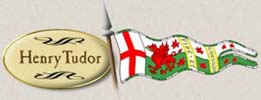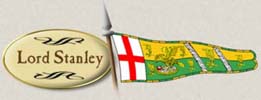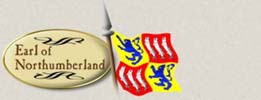 |
|
|
Richard's army was just under 12,000 strong, but 4,000 of his troops were commanded by the Stanley brothers, whose loyalty was suspect. Richard was at Nottingham, and marched from there to Leicester on 19 August, and by 21 August the two armies were facing each other about two and a half miles south of Market Bosworth. Richard took the superior position, but did not take advantage by attacking Henry while he was still deploying his troops. He was unsure of Northumberland's allegiance and positioned him in a supportive role only, perhaps to watch over the Stanleys whose allegiance was even more suspect. The Stanley's though commanded a third of his troops, Richard had to rely upon them, so placed them to the north, near to Shenton to enclose Henry's army to the North.
In 1485, Henry Tudor, Earl of Richmond, set sail from the port of Harfleur in France with 2000 troops, aiming to seize the English throne. He landed at Milford Haven in Wales on August 7 and gathered reinforcements as he marched through Wales, then through Shrewsbury, Stafford and Atherstone. On the day of battle he commanded an army of 5000 men. Marching eastwards to meet his adversary, King Richard III, Henry had qualms about the task ahead. Between Lichfield and Tamworth he spent a night away from his soldiers contemplating the wisdom of his mission. It is said that he even considered deserting. However, a secret meeting in Atherstone with Lord Stanley, a leader of the enemy forces, restored his nerve. What was said at the meeting, we do not know, but its outcome decided the future of England. Henry entered the battlefield before Richard and took position at the base of Ambion Hill rather than the seeming advantage of taking the hill's crest, perhaps hoping that the marshy ground to his south would hinder any attackers.
All through the War of the Roses the Stanleys had switched allegiances depending on political expedience and which house would provide them with the most power. Before the Battle of Bosworth, Lord Stanley was considering switching his allegiance to Henry, who happened to be his stepson. Stanley's forces had pitched their tents in a dale north of Atherstone, perhaps at the confluence of the Rivers Sence and Anker, near the place somewhat inappropriately marked on the map as 'King Dick's Hole'. Stanley heard mass in St Mary's chapel on Sunday 21st August. Possibly that night, under cover of darkness, Henry crept down from the woods, across the town and met his supposed adversary. Stanley stepped out the next morning with all the appearance of joining Richard's formations, but neither Henry nor Richard could know for certain which side the Stanleys' 4000 troops he would take in the battle.
Northumberland Although the Earls of Northumberland fought for the Lancastrian succession, Richard had assisted them in reestablishing their lands and rule against the Scots. It was with this legacy in mind that Lord Henry Percy, Earl of Northumberland, bought his 3000 strong army on to the battlefield in support of Richard. Under orders from Richard, his troops were situated to Richards' Flank and to the East of the Stanleys. |



